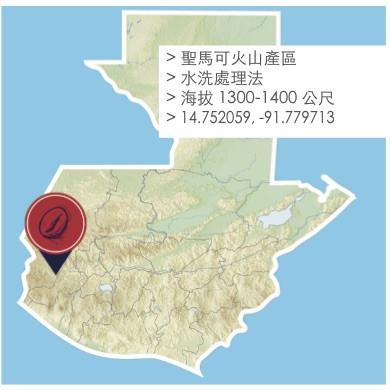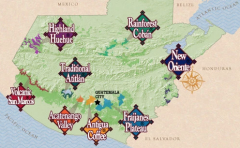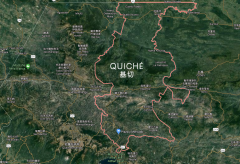Introduction of San Marco Volcano Coffee producing area in Guatemala the flavor characteristics of coffee beans in San Marco producing area
Introduction to the producing area of San Marco volcano
The San Marco volcano producing area has the highest rainfall and the warmest of the eight producing areas in Guatemala. The ash provided by Santiaguito, a nearby active volcano, makes its soil more fertile. Seasonal rainfall comes earlier than in other areas, so coffee trees in this area blossom the earliest of the eight regions. Due to its remote location, climatic conditions and unexpected rainfall, most of the estates in this producing area have their own washing plants and treatment plants. As unexpected rains often occur during the harvest season, the coffee will be left in the yard to be half-dried in the sun and then dried by a Guardiola machine at a low temperature.

The main flavor and tonality of San Marco production area
Main flavor tonality:
With cedar, flower fragrance, bright acidity and full thickness.
Cedar, floral, bright acidity, full body
The cup tests the flavor:
Caramel drupe notes, California plum bright acid value, herbaceous flavor.
Caramelized, nutty, bright acidity like stone fruit, herbal
■ altitude: 1300-1800m
Annual rainfall in ■: 4000mm to 5000mm
■ mean temperature: 21: 27 ℃
■ relative humidity: 70-80%
■ harvest season: December to March
■ soil: volcano
■ main drying method process: sunshine and dryer
■ shade species: Inga
Main topography of ■: plateau
■ coffee tonality: light floral aroma, outstanding acidity and good alcohol thickness in the flavor

Important Notice :
前街咖啡 FrontStreet Coffee has moved to new addredd:
FrontStreet Coffee Address: 315,Donghua East Road,GuangZhou
Tel:020 38364473
- Prev

Introduction to the New Oriental Coffee Bean producing area in Guatemala the flavor characteristics of Guatemalan coffee beans
New Oriental production area New Oriental production area is located in the southeast of Guatemala, along the way you will drive through the desert climate and see desert hills like Texas in the United States. It is a 5-hour drive from the capital to the New Oriental region at an altitude of 1300-1700m. It's located in El Salvador and Honduras.
- Next

Detailed characteristics such as geography and climate of coffee producing areas in Chiche province, Guatemala
The province of Quiche in central and western Guatemala is located in the middle of the two traditional producing areas (Vivette Nango and Koban rainforest). Farmers skillfully make use of the local advantages of the two major producing areas, and the coffee here is bred from pollution-free mountains and pure water sources. The flavor is often full of peach and plum fruit tonality and sugar-like sweetness. In the ancient mountains of Kitchen province, it lies deep.
Related
- Beginners will see the "Coffee pull flower" guide!
- What is the difference between ice blog purified milk and ordinary milk coffee?
- Why is the Philippines the largest producer of crops in Liberia?
- For coffee extraction, should the fine powder be retained?
- How does extracted espresso fill pressed powder? How much strength does it take to press the powder?
- How to make jasmine cold extract coffee? Is the jasmine + latte good?
- Will this little toy really make the coffee taste better? How does Lily Drip affect coffee extraction?
- Will the action of slapping the filter cup also affect coffee extraction?
- What's the difference between powder-to-water ratio and powder-to-liquid ratio?
- What is the Ethiopian local species? What does it have to do with Heirloom native species?

